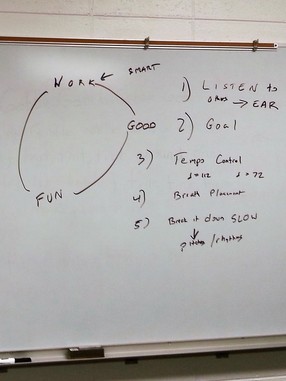 Everything we do on the tuba and euphonium is predicated upon a free flowing air stream. I am an advocate of breathing exercises to facilitate tone production and musicality. However, it is worthwhile to consider a few ancillary factors that could impede your air flow. Hear the music. If you don’t have an aural concept of the music you cannot replicate it on your instrument. Listen to recordings. Sing! Control the pitches and rhythm. Have you ever sight-read and found yourself staring at an unfamiliar rhythm? In that moment, was your air freely flowing or was it restricted? The same sensation can be the result of unfamiliarity with pitches and fingerings. How does this impact your ability to employ a free-flowing air stream? Hesitation with rhythms and pitches can lead to hiccups in the air stream and create tension. This is why it is crucial to practice at slow tempi where you can execute the phrase comfortably! Slow practice is an effective way to learn pitches and rhythms. More importantly, slow practice cultivates relaxation and allows the musician to reinforce the proper fundamentals of breath support. Control the tempo. Tempo control is vital in slower and lyrical literature. Find a happy medium where musical expression feels natural. Plan your breaths. Even the obvious ones. Don’t assume. If you breathe too soon it may compound physical tension AND interrupt the musical phrase. And worse yet, you probably didn’t inhale any wind. If you wait too long to breathe, its placement may not coincide with the phrase. In doing so, you probably struggled, gasped for air, and compounded the tension even further. In summary, hear the music, sing, practice slowly, and plan your tempi and phrasing. This will foster relaxation which will in turn allow for an uninterrupted flow of wind.
0 Comments
Your comment will be posted after it is approved.
Leave a Reply. |
Archives
October 2021
Categories |

 RSS Feed
RSS Feed